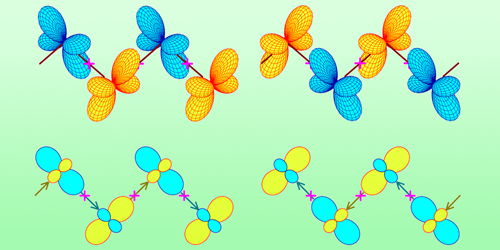Ferromagnetic Ferroelectricity from Orbital Ordering
Designers of electronic devices would love a material whose ferromagnetism can be flipped with a modest electric field and whose ferroelectricity can be flipped with a modest magnetic field—a so-called multiferroic. Unfortunately, the crystal structures that harbor ferromagnetism are not the ones that harbor ferroelectricity and vice versa. Routes to realizing such multiferroics have typically entailed stacking layers of different crystals or applying mechanical strain. Now Igor Solovyev of Japan’s National Institute for Materials Science and his collaborators have identified criteria that could endow a ferromagnetic crystal with an intrinsic multiferroicity [1]. What’s more, they propose that vanadium(III) iodide (VI3), whose precise structure is uncertain, could meet those criteria.
One way that a crystal can be ferromagnetic is through the Kugel-Khomskii mechanism, which stipulates how the orbital angular momentum of electrons can lower the energy cost to align the electrons’ spins. This tendency can be enhanced by Hund’s second rule, which states that electrons orbiting in the same sense will have lower energy than those orbiting in the opposite sense. Ferroelectricity depends on an ion being offset from the center of the unit cell—that is, on the crystal breaking inversion symmetry. Solovyev and his collaborators realized that if two ferromagnetic ions with the right kind of orbitals are positioned on either side of the inversion center, then the Hund-enhanced Kugel-Khomskii mechanism would break inversion symmetry by itself, thereby making the ferromagnetic crystal ferroelectric.
The researchers illustrated their theory using two idealized materials, a 1D zigzag chain and a 2D honeycomb lattice. According to their detailed calculations, a real material—the layered and somewhat fragile ferromagnet VI3—could also be intrinsically multiferroic. Clinching the case hinges on ensuring that VI3 has, or can be made to adopt, the appropriate orbital configuration.
–Charles Day
Charles Day is a Senior Editor for Physics Magazine.
References
- I. V. Solovyev et al., “Ferromagnetic ferroelectricity due to the Kugel-Khomskii mechanism of orbital ordering assisted by atomic Hund's second rule effects,” Phys. Rev. B 110, 205116 (2024).




